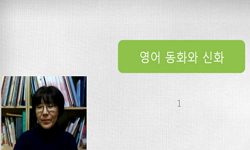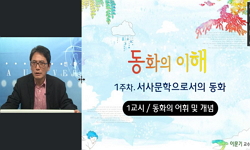This paper explores the complex relations between the emergence of the middle class, commercial market and children’s literature as entertainment takes its place firmly alongside instruction. It is widely accepted that children’s literature as a s...
http://chineseinput.net/에서 pinyin(병음)방식으로 중국어를 변환할 수 있습니다.
변환된 중국어를 복사하여 사용하시면 됩니다.
- 中文 을 입력하시려면 zhongwen을 입력하시고 space를누르시면됩니다.
- 北京 을 입력하시려면 beijing을 입력하시고 space를 누르시면 됩니다.

오락성을 향한 여정: 챕북과 탄생기 아동문학의 발달 과정과 상호성 = Progress of Entertainment: Chapbooks in Early Children’s Literature
한글로보기부가정보
다국어 초록 (Multilingual Abstract)
This paper explores the complex relations between the emergence of the middle class, commercial market and children’s literature as entertainment takes its place firmly alongside instruction. It is widely accepted that children’s literature as a separate genre of writing began in the eighteenth century as part of the modern idea of the child and childhood that emerged in the same period. John Newbury stands at the very beginning of this new development with the publication of his Little Pretty Pocket Book (1744), in which he states the two purposes of his book: instruction and amusement. The tradition of didacticism has always been strong in books that children were encouraged to read, and in the eighteenth century increasingly it served through education to meet the goal of the new middle class. But at the same time, popular literature that included fairy tales, medieval romances and fables, provided mainly through chapbooks, had been steady reading materials for children although they were considered dangerous as providing merely pleasure and amusement. However in the eighteenth century, pleasure/entertainment found a legitimate way into children’s literature as popular tales assimilated some didactic elements to become more respectable. Behind this change in favour of entertainment is the emergence of the commercial market in which children’s books became a highly valued commodity.
참고문헌 (Reference)
1 Townsend, John Rowe, "Written for Children: An Outline of English-Language Children’s Literature" Scarecrow 1996
2 F. Newbery, "The sugar plumb; or sweet amusement for leisure hours: being an entertaining and instructive collection of stories. Embellished with curious cuts" Eighteenth Century Collections Online
3 M. Cooper, "The child’s new play-thing: being a spelling-book intended to make the learning to read, a diversion instead of a task Consisting of Scripture-Histories, Fables, Stories, Moral and Religious Precepts, Proverbs, Songs, Riddles, Dialogues, &c. The Whole adapted to the Capacities of Children, and Divided into Lessons of one, two, three, and four Syllables; with entertaining Pictures to each Story and Fable, And a new-invented Alphabet for Children to paly with, and a Preface shewing the Use of it" Eighteenth Century Collections Online
4 Bettelheim, Bruno, "The Uses of Enchantment: The Meaning and Importance of Fairy Tales" Vintage 1989
5 Edgeworth, Maria, "The Parent’s Assistant; or, Stories for Children" 1796
6 Avery, Gillian, "The Oxford Companion to Fairy T" Oxford UP 66-77, 2000
7 Greenblatt, Stephen, "The Norton Anthology of English Literature. Vol 1" Norton 2006
8 Zipes, Jack, "The Norton Anthology of Children’s Literature: The Traditions in English" Norton 2005
9 Plumb, J. H., "The New World of Children in Eighteenth-Century England" 67 : 64-95, 1975
10 O’Malley, Andrew, "The Making of the Modern Child" Routledge 2011
1 Townsend, John Rowe, "Written for Children: An Outline of English-Language Children’s Literature" Scarecrow 1996
2 F. Newbery, "The sugar plumb; or sweet amusement for leisure hours: being an entertaining and instructive collection of stories. Embellished with curious cuts" Eighteenth Century Collections Online
3 M. Cooper, "The child’s new play-thing: being a spelling-book intended to make the learning to read, a diversion instead of a task Consisting of Scripture-Histories, Fables, Stories, Moral and Religious Precepts, Proverbs, Songs, Riddles, Dialogues, &c. The Whole adapted to the Capacities of Children, and Divided into Lessons of one, two, three, and four Syllables; with entertaining Pictures to each Story and Fable, And a new-invented Alphabet for Children to paly with, and a Preface shewing the Use of it" Eighteenth Century Collections Online
4 Bettelheim, Bruno, "The Uses of Enchantment: The Meaning and Importance of Fairy Tales" Vintage 1989
5 Edgeworth, Maria, "The Parent’s Assistant; or, Stories for Children" 1796
6 Avery, Gillian, "The Oxford Companion to Fairy T" Oxford UP 66-77, 2000
7 Greenblatt, Stephen, "The Norton Anthology of English Literature. Vol 1" Norton 2006
8 Zipes, Jack, "The Norton Anthology of Children’s Literature: The Traditions in English" Norton 2005
9 Plumb, J. H., "The New World of Children in Eighteenth-Century England" 67 : 64-95, 1975
10 O’Malley, Andrew, "The Making of the Modern Child" Routledge 2011
11 Kilner, Dorothy, "The Life and Perambulations of a Mouse" Astounding Stories 2015
12 Aldermary Church-Yard, "The History of guy, Earl of Warwick" Eighteenth Century Collections Online
13 Day, Thomas, "The History of Sandford and Merton" Dublin 1787
14 Newbery, John, "The History of Little Goody Two Shoes" 1765
15 Fielding, Sarah, "The Governess" 1st World Library 2009
16 Stone, Lawrence, "The Family, Sex and Marriage in England 1500-1800" Harper & Row 1979
17 Grenby, M. O., "The Cambridge Companion to Children’s Literature" Cambridge UP 3-18, 2009
18 Immel, Andrea, "The Cambridge Companion to Children’s Literature" Cambridge UP 19-34, 2009
19 Wilson, Spence, "The British champion; or, honour rewarded. Containing, I. The history of St. George and the dragon. II. The Story of Miss Friendly and the Merchant. III. Rural Happiness. IV. The Fairy’s Present; or, The History of Miss K. Graceful. V. The pleasing story of master Want-Thought" Eighteenth Century Collections Online
20 Grenby, M. O, "Tame Fairies Make Good Teachers: The Popularity of Early British Fairy Tales" 30 : 1-24, 2006
21 Locke, John, "Some Thoughts Concerning Education" Thoemmes 1995
22 Brockman, Bennett A, "Robin Hood and the Invention of Children’s Literature" 10 : 1-17, 1982
23 Neuberg, Victor E., "Popular literature: A History and Guide from the Beginning of Printing to the Year 1897" Routledge 2014
24 Tabart, Benjamin, "Popular Fairy Tales, or a Lilliputian Library" Sir Richard Phillips and Co
25 Shavit, Zohar, "Poetics of Children’s Literature" Georgia UP 2009
26 Aulnoy, Madame d’ (Marie-Catherine), "Mother bunch’s fairy tales. Published for the amusement of all those little masters and misses who, by duty to their parents, and obedience to their superiors, aim at becoming great lords and ladies. Adorned with copperplate cuts"
27 Bottigheimer, Ruth B, "Misperceived Perceptions: Perrault’s Fairy Tales and English Children’s Literature" 30 : 1-18, 2002
28 Richardson, Alan, "Literature, Education, and Romanticism: Reading as Social Practice, 1780-1832" Cambridge UP 1994
29 Warner, William. B., "Licensing Entertainment: The Elevation of Novel Reading in Britain, 1684-1750" U of California P 1998
30 Barbauld, Anna Laetitia, "Lessons for Children" 1778
31 Townsend, John Rowe, "John Newbery and his Books: Trade and Plumb-Cakes For Ever, Huzza! Metuchen" Scarecrow 1994
32 Pickering, Samuel F. Jr., "John Locke and Children’s Books in Eighteenth-Century England" Tennessee UP 1981
33 Kinnell, Margaret, "International Companion Encyclopedia of Children’s Literature" Routledge 141-151, 1996
34 Perrault, Charles, "Histories or tales of past times, told by mother goose. With morals" 1791
35 Pedersen, Susan, "Hannah More Meets Simple Simon: Tracts, Chapbooks, and Popular Culture in Late Eighteenth-Century England" 25 (25): 84-113, 1986
36 Demers, Patricia, "From Instruction to Delight: An Anthology of Children’s Literature to 1850" Oxford UP 2008
37 Bradley, Johanna, "From Chapbook to Plumb Cake: The History of Children’s Literature" U of Illinois 2007
38 Summerfield, Geoffrey, "Fantasy & Reason" Georgia UP 1984
39 William Lane, "Fairy tales; selected from the best authors. In two volumes. . . . Vol. 1" the Minerva-Press
40 Zipes, Jack, "Fairy Tale as Myth. Myth as Fairy Tale" Kentucky UP 1994
41 Trimmer, Sarah, "Fabulous Histories. Designed for the Instruction of Children" 1798
42 Barbauld, Anna Laetitia, "Evenings at Home; or, The Juvenile Budget" Opened 1795
43 Jackson, Mary V., "Engines of Instruction, Mischief, and Magic: Children’s Literature in England from its Beginnings to 1839" Nebraska UP 1989
44 Hunt, Peter, "Children’s Literature" Blackwell 2001
45 Darton, Harvey F. J., "Children’s Books in England" Cambridge UP 1982
46 Grenby, M. O., "Chapbooks, children, and Children’s Literature" 8 (8): 277-303, 2007
47 Ariès, Philippe, "Centuries of Childhood: A Social History of Family Life" Vintage 1962
48 Newbery, John, "A Little Pretty Pocket Book" 1744
동일학술지(권/호) 다른 논문
-
Occupational Cross-Dressing in the Autobiographies of Hannah Snell and Charlotte Charke
- 한국18세기영문학회
- 류혜원
- 2020
- KCI등재
-
유령과 유령적 모성: [록사나]에 나타난 외상과 복수 환상을 중심으로
- 한국18세기영문학회
- 최유진
- 2020
- KCI등재
-
Soul, Body, and Masculine Women in Margaret Cavendish’s Blazing World
- 한국18세기영문학회
- 최유정
- 2020
- KCI등재
-
- 한국18세기영문학회
- 윤석민
- 2020
- KCI등재
분석정보
인용정보 인용지수 설명보기
학술지 이력
| 연월일 | 이력구분 | 이력상세 | 등재구분 |
|---|---|---|---|
| 2026 | 평가예정 | 재인증평가 신청대상 (재인증) | |
| 2020-01-01 | 평가 | 등재학술지 유지 (재인증) |  |
| 2017-01-01 | 평가 | 등재학술지 유지 (계속평가) |  |
| 2013-01-01 | 평가 | 등재학술지 유지 (등재유지) |  |
| 2010-01-01 | 평가 | 등재학술지 선정 (등재후보2차) |  |
| 2009-01-01 | 평가 | 등재후보 1차 PASS (등재후보1차) |  |
| 2007-01-01 | 평가 | 등재후보학술지 선정 (신규평가) |  |
학술지 인용정보
| 기준연도 | WOS-KCI 통합IF(2년) | KCIF(2년) | KCIF(3년) |
|---|---|---|---|
| 2016 | 0.25 | 0.25 | 0.24 |
| KCIF(4년) | KCIF(5년) | 중심성지수(3년) | 즉시성지수 |
| 0.21 | 0.17 | 0.877 | 0 |




 KCI
KCI KISS
KISS






